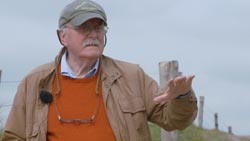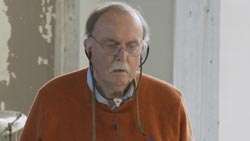| FILMMAKERS’ NOTES There are several ways to make a documentary portrait. We decided to portray Alvin Lucier primarily on the basis of his work. This should come as no surprise since with the line “Don’t ask me what I mean, ask me what I’ve made” by the American poet William Carlos Williams, Lucier himself draws attention to his works. Following this motto, our film accompanies Alvin Lucier on concert travels to The Hague (Netherlands) and Zug (Switzerland). Between rehearsals and in conversations, Lucier explains and comments on his œuvre.
Another reason to focus on Lucier’s work is that many of his compositions have strong visual and theatrical aspects – a very appropriate situation for a filmic presentation.
Right from the beginning, we decided to use the seminal work I AM SITTING IN A ROOM (1969) as the main structuring element. The various process steps of the piece divide the film into chapters so that this work serves as an integral part of the film. We were able to film I AM SITTING IN A ROOM during our first shooting in Middletown (Lucier’s hometown) in January 2010. At his home, Lucier also performed OPERA WITH OBJECTS for us, a piece he had originally written for his students. The simplicity and accessibility of this piece made it an ideal opener for our film (Prologue).
Our next shooting took place in The Hague in 2011. Lucier had informed us beforehand about a very special occasion: an installation version of SFERICS (1981) was going to be realized inside and around the “Celestial Vault,” an artificial crater by James Turrell situated in the dunes outside of The Hague. This gave us the opportunity to start the film with a rather unexpected outdoor scene and an atmosphere of “field work” that Lucier himself enjoyed a lot (Chapter 1).
Fortunately, the event “Alvin Lucier in The Hague” also featured many other works of Lucier, especially two important live electronic works from the sixties and seventies: MUSIC FOR SOLO PERFORMER and BIRD AND PERSON DYNING (Chapter 2) and in addition his lovely teapot-and-piano piece NOTHING IS REAL (Chapter 5). These pieces had already been at the top of our wish list, since MUSIC FOR SOLO PERFORMER (1965) marked an important breakthrough in Lucier’s career and BIRD AND PERSON DYNING (1975) and NOTHING IS REAL (1990) are works that Lucier continues to perform himself. As his wife Wendy says, Lucier is a “born performer,” and not only has he performed his own works (and those of his colleagues of the Sonic Arts Union) during his whole career, he even starred in the film trilogy “Dr. Chicago” by George Manupelli (1968–1971). So there was no doubt that we wanted to show Lucier performing some of his pieces. We even decided to make a parallel montage with Lucier performing MUSIC FOR SOLO PERFORMER in the seventies and the actual performance of the piece in The Hague in 2011. It is also very interesting to detect the slight differences in the realization of the two performances.
The last chapters of our film (Chapters 6 and 7) are set in Zug, Switzerland, where MUSIC ON A LONG THIN WIRE, for sure the most challenging and most requested sound installation in Lucier’s œuvre, was installed as an “overhead” version running through the whole length of the Kunsthaus Zug (Chapter 6).
On this occasion, there were also two concerts with more recent chamber and orchestra works of Lucier concentrating on acoustical beatings of closely tuned pitches – a phenomenon that Lucier has been interested in since the beginning of the eighties. IN MEMORIAM JON HIGGINS is an early and PANORAMA 2 a recent example of this series of works (Chapter 7).
In general, our film moves chronologically from Lucier’s early pieces to more recent ones. This movement is intersected by two chapters, each with a different focus: in Chapter 3, Lucier talks about the beginning of his pioneering career and his time with the SONIC ARTS UNION. Relating to John Cage and David Tudor, he provides insights into his early influences and artistic attitude. In Chapter 4, we follow Lucier to Wesleyan University in Middletown, where he has taught since 1970. We filmed him teaching an undergraduate class. In the second part of the chapter, Lucier prepares for us his minimalistic PASTA FOR TIRED DANCERS. “No Ideas but in Things” – we decided to borrow one of Lucier’s favorite quotes by William Carlos Williams as the title of our film. In all his works, Lucier concentrates on sound itself, revealing its acoustical and physical properties. During the process of composing, all unnecessary aspects are eliminated in order to make the phenomenon itself as clear as possible. To find another equivalent to Lucier’s composing, we tried to keep a slow pace throughout the film, with only little camera movement and a “space-time coherence” within each chapter.
| | THE FILM 
TEXT BY DANIEL JAMES WOLF 
FILMMAKERS’ NOTES 
DESCRIPTION OF PIECES 
MAKING OF PHOTOS 
DIRECTORS 
ALVIN LUCIER 
TRAILER 
CREDITS 
NEWS 
CONTACT 
| |







